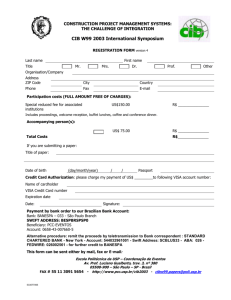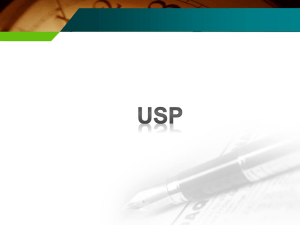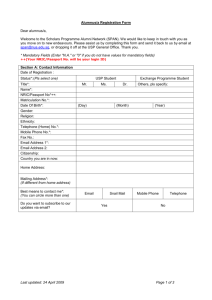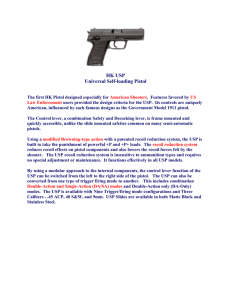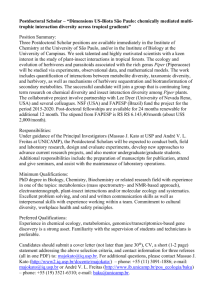USP General Chapter Changes – Pharmaceutical Microbiology
advertisement
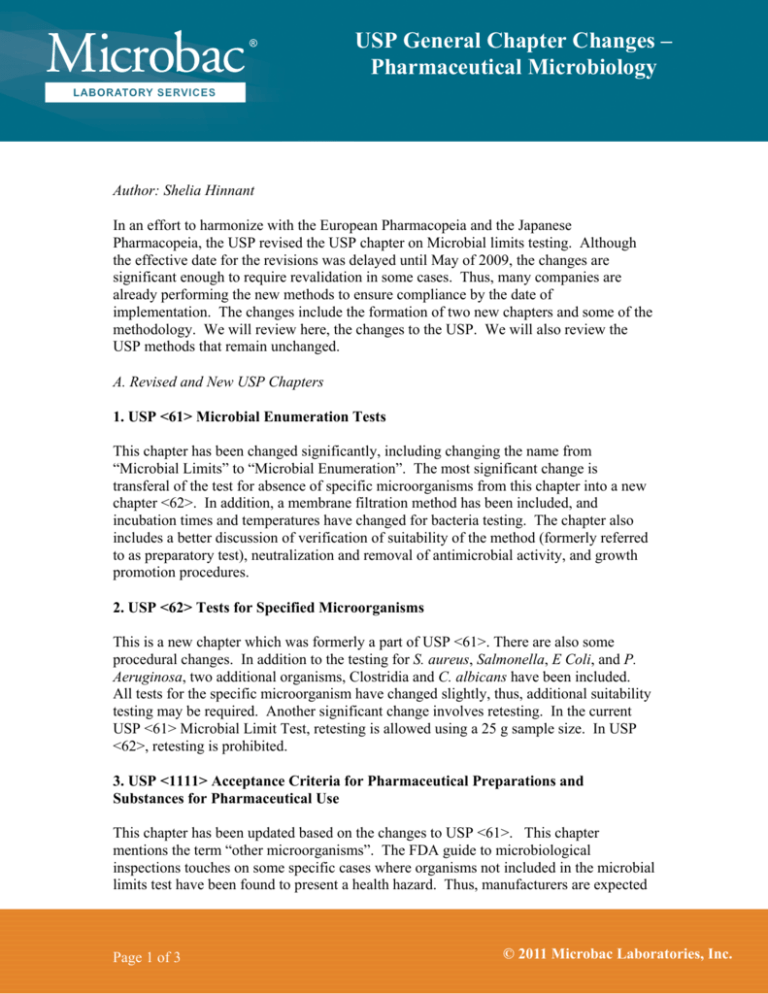
USP General Chapter Changes – Pharmaceutical Microbiology Author: Shelia Hinnant In an effort to harmonize with the European Pharmacopeia and the Japanese Pharmacopeia, the USP revised the USP chapter on Microbial limits testing. Although the effective date for the revisions was delayed until May of 2009, the changes are significant enough to require revalidation in some cases. Thus, many companies are already performing the new methods to ensure compliance by the date of implementation. The changes include the formation of two new chapters and some of the methodology. We will review here, the changes to the USP. We will also review the USP methods that remain unchanged. A. Revised and New USP Chapters 1. USP <61> Microbial Enumeration Tests This chapter has been changed significantly, including changing the name from “Microbial Limits” to “Microbial Enumeration”. The most significant change is transferal of the test for absence of specific microorganisms from this chapter into a new chapter <62>. In addition, a membrane filtration method has been included, and incubation times and temperatures have changed for bacteria testing. The chapter also includes a better discussion of verification of suitability of the method (formerly referred to as preparatory test), neutralization and removal of antimicrobial activity, and growth promotion procedures. 2. USP <62> Tests for Specified Microorganisms This is a new chapter which was formerly a part of USP <61>. There are also some procedural changes. In addition to the testing for S. aureus, Salmonella, E Coli, and P. Aeruginosa, two additional organisms, Clostridia and C. albicans have been included. All tests for the specific microorganism have changed slightly, thus, additional suitability testing may be required. Another significant change involves retesting. In the current USP <61> Microbial Limit Test, retesting is allowed using a 25 g sample size. In USP <62>, retesting is prohibited. 3. USP <1111> Acceptance Criteria for Pharmaceutical Preparations and Substances for Pharmaceutical Use This chapter has been updated based on the changes to USP <61>. This chapter mentions the term “other microorganisms”. The FDA guide to microbiological inspections touches on some specific cases where organisms not included in the microbial limits test have been found to present a health hazard. Thus, manufacturers are expected Page 1 of 3 © 2011 Microbac Laboratories, Inc. USP General Chapter Changes – Pharmaceutical Microbiology to develop microbial specifications for each of their products. There are circumstances in which a product will not validate at the limits described in this chapter. When a product does not validate at the limits of this chapter, a validated method with the limit of detection as close to the specified limit in this chapter must be determined. B. USP Chapters without major revision 1. USP <51> Antimicrobial Effectiveness Testing This test determines the effectiveness of the preservative system. Known inoculum levels of specified organisms are added to the sample and plated at certain time intervals to determine the reduction of organisms. Criteria for reductions are specified in the method and organized by the product category as to whether or not the product complies with the test. 2. USP <85> Bacterial Endotoxin Test This test is for the detection or quantitation of bacterial endotoxins that may be present in the pharmaceutical article. It uses Limulus Amebocyte Lysate (LAL) obtained from the aqueous extracts of circulating amebocytes of horseshoe crab which has been prepared and characterized for us as an LAL Reagent. There are two techniques, which are based on gel formation, and the photometric techniques. The turbidimetric method is based on the development of turbidity after cleavage of an endogenous substrate, and a chromogenic method, which is based on a color reaction after cleavage with a synthetic peptide-chromogen complex. Either of these methods is acceptable, unless the individual monograph specifies differently. Article specifications are listed in the individual monographs. 3. <1112> Application of Water Activity Determination to Non-sterile Pharmaceutical Products This chapter was added to the USP in 2006 for non-sterile pharmaceutical products and provides guidelines in making decisions regarding the following: a. Optimizing product formulations to improve preservative systems b. Reducing degradation of active ingredients in products that are susceptible to chemical hydrolysis c. Reducing microbial contamination in those products that are susceptible, such as liquids, ointments, lotions and creams Page 2 of 3 © 2011 Microbac Laboratories, Inc. USP General Chapter Changes – Pharmaceutical Microbiology d. A tool for reducing the frequency of microbial testing 4. USP <2021> Microbial Enumeration Tests-Nutritional and Dietary Supplements This chapter provides tests for the estimation of the number of total aerobic microbial count, total combined yeast and mold counts, and the presence of bile-tolerant gramnegative bacteria present in all nutritional supplements, from raw materials to the finished product. Product specifications are outlined in USP <2023>, but typically are developed by the manufacturer. 5. USP <2022> Microbiological Procedures for Absence of Specified Microorganisms-Nutritional and Dietary Supplements This chapter provides procedures for determining the absence of specified objectionable organisms. Good manufacturing practices require that objectionable organisms be absent from non-sterile nutritional and dietary products. Objectionable organisms are defined as microorganisms that may cause potential health hazards to the user of the product and would adversely affect the product safety. Product specifications are outlined in USP <2023>, but typically are developed by the manufacturer with guidance from USP <2023>. 6. USP <2023> Microbiological Attributes of Non-sterile Nutritional and Dietary Supplements This chapter provides guidance for formulation and process design, facilities, equipment, water and sanitation, supplement components, frequency of microbiological sampling and testing, recommended microbial limits for botanical ingredients and products, and finally, recommended microbial limits for dietary supplement ingredients and products. Microbac Laboratories Inc. performs the full range of USP microbiological tests discussed above. All testing on pharmaceutical ingredients, raw materials, and products is performed in compliance with cGMP regulations. For more information, please contact: microbac_info@microbac.com Page 3 of 3 © 2011 Microbac Laboratories, Inc.
